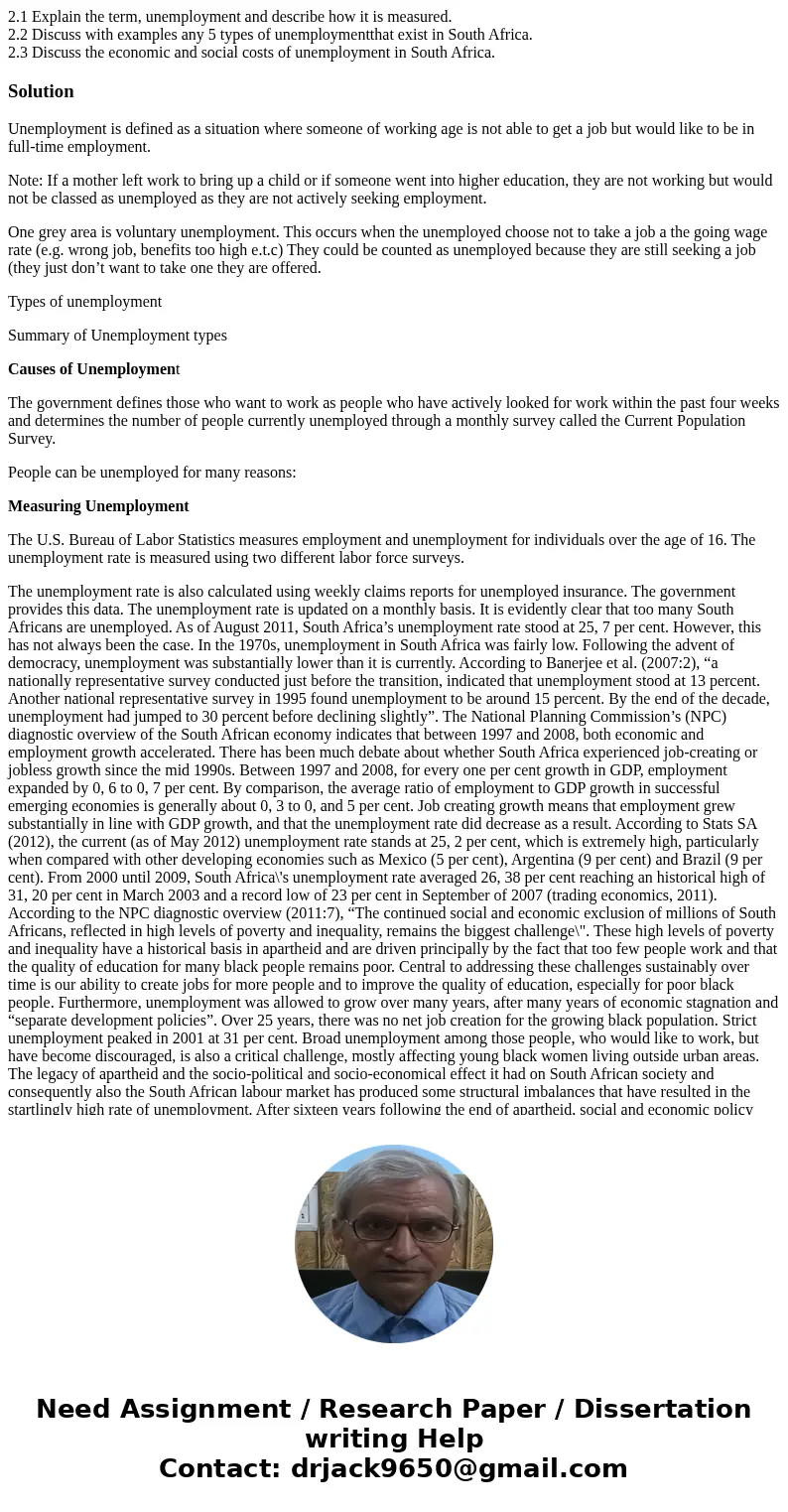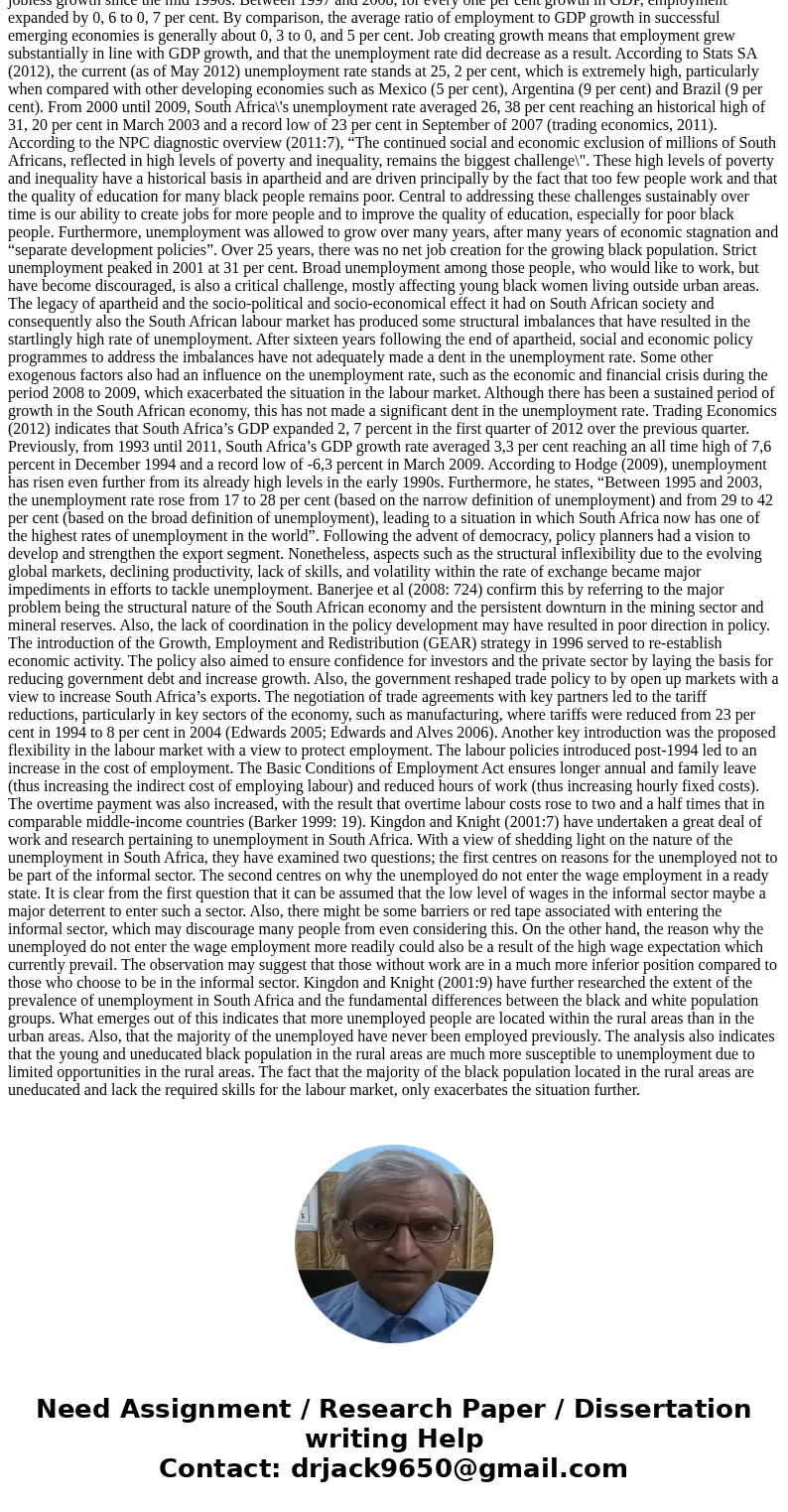21 Explain the term unemployment and describe how it is meas
2.1 Explain the term, unemployment and describe how it is measured.
2.2 Discuss with examples any 5 types of unemploymentthat exist in South Africa.
2.3 Discuss the economic and social costs of unemployment in South Africa.
Solution
Unemployment is defined as a situation where someone of working age is not able to get a job but would like to be in full-time employment.
Note: If a mother left work to bring up a child or if someone went into higher education, they are not working but would not be classed as unemployed as they are not actively seeking employment.
One grey area is voluntary unemployment. This occurs when the unemployed choose not to take a job a the going wage rate (e.g. wrong job, benefits too high e.t.c) They could be counted as unemployed because they are still seeking a job (they just don’t want to take one they are offered.
Types of unemployment
Summary of Unemployment types
Causes of Unemployment
The government defines those who want to work as people who have actively looked for work within the past four weeks and determines the number of people currently unemployed through a monthly survey called the Current Population Survey.
People can be unemployed for many reasons:
Measuring Unemployment
The U.S. Bureau of Labor Statistics measures employment and unemployment for individuals over the age of 16. The unemployment rate is measured using two different labor force surveys.
The unemployment rate is also calculated using weekly claims reports for unemployed insurance. The government provides this data. The unemployment rate is updated on a monthly basis. It is evidently clear that too many South Africans are unemployed. As of August 2011, South Africa’s unemployment rate stood at 25, 7 per cent. However, this has not always been the case. In the 1970s, unemployment in South Africa was fairly low. Following the advent of democracy, unemployment was substantially lower than it is currently. According to Banerjee et al. (2007:2), “a nationally representative survey conducted just before the transition, indicated that unemployment stood at 13 percent. Another national representative survey in 1995 found unemployment to be around 15 percent. By the end of the decade, unemployment had jumped to 30 percent before declining slightly”. The National Planning Commission’s (NPC) diagnostic overview of the South African economy indicates that between 1997 and 2008, both economic and employment growth accelerated. There has been much debate about whether South Africa experienced job-creating or jobless growth since the mid 1990s. Between 1997 and 2008, for every one per cent growth in GDP, employment expanded by 0, 6 to 0, 7 per cent. By comparison, the average ratio of employment to GDP growth in successful emerging economies is generally about 0, 3 to 0, and 5 per cent. Job creating growth means that employment grew substantially in line with GDP growth, and that the unemployment rate did decrease as a result. According to Stats SA (2012), the current (as of May 2012) unemployment rate stands at 25, 2 per cent, which is extremely high, particularly when compared with other developing economies such as Mexico (5 per cent), Argentina (9 per cent) and Brazil (9 per cent). From 2000 until 2009, South Africa\'s unemployment rate averaged 26, 38 per cent reaching an historical high of 31, 20 per cent in March 2003 and a record low of 23 per cent in September of 2007 (trading economics, 2011). According to the NPC diagnostic overview (2011:7), “The continued social and economic exclusion of millions of South Africans, reflected in high levels of poverty and inequality, remains the biggest challenge\". These high levels of poverty and inequality have a historical basis in apartheid and are driven principally by the fact that too few people work and that the quality of education for many black people remains poor. Central to addressing these challenges sustainably over time is our ability to create jobs for more people and to improve the quality of education, especially for poor black people. Furthermore, unemployment was allowed to grow over many years, after many years of economic stagnation and “separate development policies”. Over 25 years, there was no net job creation for the growing black population. Strict unemployment peaked in 2001 at 31 per cent. Broad unemployment among those people, who would like to work, but have become discouraged, is also a critical challenge, mostly affecting young black women living outside urban areas. The legacy of apartheid and the socio-political and socio-economical effect it had on South African society and consequently also the South African labour market has produced some structural imbalances that have resulted in the startlingly high rate of unemployment. After sixteen years following the end of apartheid, social and economic policy programmes to address the imbalances have not adequately made a dent in the unemployment rate. Some other exogenous factors also had an influence on the unemployment rate, such as the economic and financial crisis during the period 2008 to 2009, which exacerbated the situation in the labour market. Although there has been a sustained period of growth in the South African economy, this has not made a significant dent in the unemployment rate. Trading Economics (2012) indicates that South Africa’s GDP expanded 2, 7 percent in the first quarter of 2012 over the previous quarter. Previously, from 1993 until 2011, South Africa’s GDP growth rate averaged 3,3 per cent reaching an all time high of 7,6 percent in December 1994 and a record low of -6,3 percent in March 2009. According to Hodge (2009), unemployment has risen even further from its already high levels in the early 1990s. Furthermore, he states, “Between 1995 and 2003, the unemployment rate rose from 17 to 28 per cent (based on the narrow definition of unemployment) and from 29 to 42 per cent (based on the broad definition of unemployment), leading to a situation in which South Africa now has one of the highest rates of unemployment in the world”. Following the advent of democracy, policy planners had a vision to develop and strengthen the export segment. Nonetheless, aspects such as the structural inflexibility due to the evolving global markets, declining productivity, lack of skills, and volatility within the rate of exchange became major impediments in efforts to tackle unemployment. Banerjee et al (2008: 724) confirm this by referring to the major problem being the structural nature of the South African economy and the persistent downturn in the mining sector and mineral reserves. Also, the lack of coordination in the policy development may have resulted in poor direction in policy. The introduction of the Growth, Employment and Redistribution (GEAR) strategy in 1996 served to re-establish economic activity. The policy also aimed to ensure confidence for investors and the private sector by laying the basis for reducing government debt and increase growth. Also, the government reshaped trade policy to by open up markets with a view to increase South Africa’s exports. The negotiation of trade agreements with key partners led to the tariff reductions, particularly in key sectors of the economy, such as manufacturing, where tariffs were reduced from 23 per cent in 1994 to 8 per cent in 2004 (Edwards 2005; Edwards and Alves 2006). Another key introduction was the proposed flexibility in the labour market with a view to protect employment. The labour policies introduced post-1994 led to an increase in the cost of employment. The Basic Conditions of Employment Act ensures longer annual and family leave (thus increasing the indirect cost of employing labour) and reduced hours of work (thus increasing hourly fixed costs). The overtime payment was also increased, with the result that overtime labour costs rose to two and a half times that in comparable middle-income countries (Barker 1999: 19). Kingdon and Knight (2001:7) have undertaken a great deal of work and research pertaining to unemployment in South Africa. With a view of shedding light on the nature of the unemployment in South Africa, they have examined two questions; the first centres on reasons for the unemployed not to be part of the informal sector. The second centres on why the unemployed do not enter the wage employment in a ready state. It is clear from the first question that it can be assumed that the low level of wages in the informal sector maybe a major deterrent to enter such a sector. Also, there might be some barriers or red tape associated with entering the informal sector, which may discourage many people from even considering this. On the other hand, the reason why the unemployed do not enter the wage employment more readily could also be a result of the high wage expectation which currently prevail. The observation may suggest that those without work are in a much more inferior position compared to those who choose to be in the informal sector. Kingdon and Knight (2001:9) have further researched the extent of the prevalence of unemployment in South Africa and the fundamental differences between the black and white population groups. What emerges out of this indicates that more unemployed people are located within the rural areas than in the urban areas. Also, that the majority of the unemployed have never been employed previously. The analysis also indicates that the young and uneducated black population in the rural areas are much more susceptible to unemployment due to limited opportunities in the rural areas. The fact that the majority of the black population located in the rural areas are uneducated and lack the required skills for the labour market, only exacerbates the situation further.


 Homework Sourse
Homework Sourse